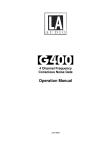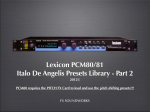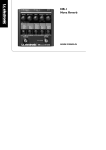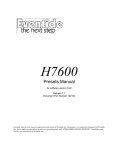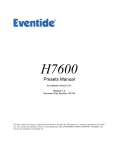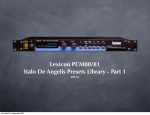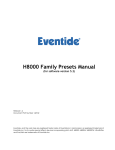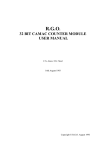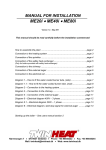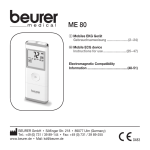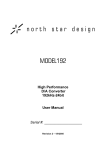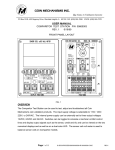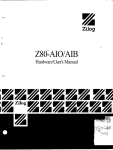Download TC 1280/1380 Manual English
Transcript
OWNERS MANUAL version 2 TC 1280 STEREO DIGITAL AUDIO DELAY Contents FEATURES FRONT PANEL AND FUNCTIONS PRESETS MIDI REMOTE UTILITY FEATURES REAR PANEL MEMORY EXPANSION ERROR MESSAGES DISTANCE MODE CALCULATION HAAS EFFECT TECHNICAL SPECIFICATIONS Page 2 3 4 4 4 5 6 7 7 8 8 9 TC1280 STEREO DIGITAL AUDIO DELAY OWNERS MANUAL Rev. 2.1, Software version 2.04 Page 1 of 9 TC1280 STEREO DIGITAL AUDIO DELAY The TC 1280 STEREO DIGITAL AUDIO DELAY is a high resolution audio delay based on the proprietary converter technology that made the TC2290 Dynamic Digital Delay a world standard in the recording industry. Two independently controlled audio channels make the TC1280 ideally suited for any system requiring precise control over audio delay. Uses include concert delay towers, balcony delay in theatres, mastering delay, audio for video format conversion, matching of video processing delays, etc. anywhere that high quality time delays are desired with minimum effect to signal quality. FEATURES: • No degradation of signal quality .The TC digital converter technology has been acclaimed as being "very musical and warm". • Soft HF roll off: -3dB @ 25 kHz and -12 dB @ 33 kHz allows ALL the signal to pass thru the device. • Dynamic range > 100 dB is excellent for live sound performances. • Absolute stereo phase linearity within 2 microseconds. • Delay time increments adjustable down to 5 microseconds for exact adjustments needed when aligning speaker driver components. • Expandable memory up to 2 x 10 seconds. • Front panel controls are lockable for permanent installation. • Remote control possible via MIDI or dedicated switches. (TC0050 footswitch allows access to presets). • Delay times may be displayed and adjusted in time, or distance (meters or feet), or video frames (25half or full frame, and 30half or full frame). • Automatic relay bypass of audio should there be a loss of power. • Non-volatile memory of delay time settings in 4 presets. TC1280 STEREO DIGITAL AUDIO DELAY OWNERS MANUAL Rev. 2.1, Software version 2.04 Page 2 of 9 FRONT PANEL KEYS AND FUNCTIONS TC 1280 STEREO DIGITAL AUDIO DELAY +3 +6 -10 +10 dB LEFT INPUT -3 0 +3 -6 +6 -10 +10 dB RIGHT INPUT -12 -9 -6 - -12 -9 -0 dB LEFT OUTPUT - OVERLOAD +3 -6 -3 -20 -20 -3 8 0 8 -3 -6 -0 dB RIGHT OUTPUT uSec. mSec. 0 -3 -10 -20 PPM dB L BYPASS MUTE METRE FEET MONO DELAY LINE DELAY DELAY UP DOWN R parameter L=R UTILITY value PARAM. VALUE SHOW DISTANCE UTILITY UTILITY LIST 0 SOFTWARE VERSION 1 RESOLUTION (microsec./frames) 2 MIDI DEVICE/CHANNEL NO. 3 RESET 4 DISTANCE MODE 5 SECURITY LOCK 6 PRESET SELECT 7 LAST ERROR 8 MIDI ERROR CORRECTION POWER <POWER> Mains power on/off switch. During start up, the unit will display the software revision number. Note: the audio signal input is connected directly to the output by a relay when power is not on. LEFT INPUT Input gain of left channel. -10dB to +10dB. RIGHT INPUT Input gain of right channel. -10 dB to + 10 dB. LEFT OUTPUT Output volume of left channel. 0dB to mute RIGHT OUTPUT Output volume of right channel. 0dB to mute PPM Peak program meter for both left and right channels. When "DELAY LINE" is adjusted for left, the PPM will display the left channel. When "DELAY LINE" is adjusting for right, the meter will display the right channel. When "DELAY LINE" is adjusted to L= R (left = right) the PPM will display the audio channel which is highest. OVERLOAD The OVERLOAD LED +3 will always display a overload on either left or right channel. BYPASS Delay bypass on left and right channels. Sets the delay time to 0 seconds. (This is not a relay bypass) MUTE Mutes both channels at output. MONO Mixes left and right inputs to a mono signal. DELAY LINE Switches between 3 positions L, R or L=R. Left channel (L) displays the delay time of left channel. Right channel (R) displays the delay time of right channel. Left = right (L= R) displays the delay time of both channels alternatively. DELAY DOWN Decreases delay time for the displayed channel (or both if L=R displayed). DELAY UP Increases delay time for the displayed channel (or both if L=R displayed). SHOW DISTANCE METRE Press the "DELAY LINE" and the "BYPASS" keys simultaneously in order to get the delay displayed in meters. Press the "DELAY LINE" or "DELAY UP" / "DELAY DOWN" to get back to time display. Note: If UTILITY PARAMETER 4 is set to VALUE 1 you can adjust the delay time in SHOW DISTANCE mode SHOW DISTANCE FEET As above, but press the "DELAY LINE" and the "MUTE" keys simultaneously in order to get the delay displayed in feet. UTILITY Please refer to UTILITY FEATURES. TC1280 STEREO DIGITAL AUDIO DELAY OWNERS MANUAL Rev. 2.1, Software version 2.04 Page 3 of 9 PRESETS The TC 1280 has 4 presets. Just make your delay setting, and these values will remain as a preset until changed. Select another preset number (UTILITY PARAMETER 6, VALUE 1 - 4) and adjust the delay time. Both are now selectable by recalling the appropriate preset number by MIDI or by remote. Note: The preset no. received on the MIDI IN is passed to the MIDI OUT on the same channel. Thus allowing daisy chaining of several TC1280s, TC1380s and other MIDI equipment. MIDI Set the UTILITY PARAMETER 2 to the appropriate MIDI channel / device number. Recall the desired preset by MIDI program change command. The bypass status of the TC1280 can be set with MIDI Controller #0: value 0-63 = BYPASS, value 64-127 = active. MIDI SYSEX documentation is available on request. Please contact your local TC distributor. REMOTE By using the remote facility on the rear panel the TC 1280 can change presets and bypass status with the TC 0050 remote pedal (Note: The TC0050 have been discontinued). The TC0050 schematic is found below: Note: The preset no. selected with the remote is sent as MIDI program change command to the MIDI OUT. Thus, several TC1280s, TC1380s and other MIDI equipment can be remotely controlled by one TC0050. TC1280 STEREO DIGITAL AUDIO DELAY OWNERS MANUAL Rev. 2.1, Software version 2.04 Page 4 of 9 UTILITY FEATURES (extra options and settings) You can access a whole extra group of parameters and features within the TC 1280 by simply pressing two buttons at the same time. PARAMETER selects what type of feature you want to adjust, and VALUE selects the choice. PARAMETER Press "DELAY LINE" and "PARAM" simultaneously to access the utility parameter number. Then select the parameter number by pressing the up/down keys. VALUE Press "DELAY LINE" and "VALUE" simultaneously to access the utility value number. Then select the value number by pressing the up/down keys. PARAMETER VALUE FUNCTION 0 Read only Display the software revision number. 1 200/500/1000 microseconds or frame select Delay step resolution or frame view select. 2 0-99 0 = MIDI off MIDI channel / device number. 3 80 80 = Reset when turning unit off/on. 4 0-1 0 = Show distance only. 1 = Show and adjust distance A. Dot in display flashes when the display is set for distance. 5 on/off Security lock. 6 1-4 Preset No. 7 Read only message. Displays last error TC1280 STEREO DIGITAL AUDIO DELAY OWNERS MANUAL Rev. 2.1, Software version 2.04 Page 5 of 9 REAR PANEL PUSH 30W/ 50-60 Hz FUSE : S SERIAL NO. OUT GROUND REMOTE LIFT IN TYPE : TC 1280 100 - 120V: T400mA 220 - 240V: T250mA R OUT L OUT MONO OUT R IN PUSH L IN MIDI L IN (left input) Left channel input. XLR balanced, pin 2 hot. R IN (right input) Right channel input. XLR balanced, pin 2 hot. MONO OUT Mono output: Sum of left and right inputs after input gain. L OUT (left output) Left channel output, XLR balanced, pin 2 hot. R OUT (right output) Right channel output, XLR balanced, pin 2 hot. REMOTE TC 0050 remote input. Please refer to page 4. MIDI IN MIDI input. MIDI OUT MIDI output. GROUND LIFT Disconnects chassis from audio ground. FUSE External fuse holder, replace only with the correct type according to mains voltage. Please refer to rear panel. MAINS INLET IEC mains inlet. Make sure that the voltage selector and fuse type set correctly according to your mains supply. TC1280 STEREO DIGITAL AUDIO DELAY OWNERS MANUAL Rev. 2.1, Software version 2.04 Page 6 of 9 MEMORY EXPANSION The TC 1280 can be expanded on the main circuit card in steps of 625 mS per channel by using the CH01 memorv expansion kit. 1250 mS per channel: Install memory chip in position IC31. Switch dip switch position 1 to ON. 1875 mS per channel: Install memory chips in position IC31 and IC32. Switch dip switch position 2 to ON. 2500 mS per channel: Install memory chips in positions IC31 and IC32, and IC33. Switch dip switch 1 and 2 to ON For further expansion: Purchase the ME80 option. Instructions will come with the option. ERROR MESSAGES The last error message number will be displayed if UTILITY 7 is selected. The values mean the following: VALUE DESCRIPTION 13 The unit has made a reset. 15 Security lock is activated. 17 You are trying to change the value of a read only parameter. 27 MIDI input error. 57 Main board and Digital board have been separated or battery voltage is low. At power on CPU standby bit is missing, therefore a Master reset is done. All settings = factory default. 58 Main board and Digital board have been separated or battery voltage is low. Check also CPU. At power on checksum in non voilating parameters is wrong, therefore a Master reset is done. All settings = factory default. All OTHER Mainly used for service purposes. Please contact your local TC distributor. TC1280 STEREO DIGITAL AUDIO DELAY OWNERS MANUAL Rev. 2.1, Software version 2.04 Page 7 of 9 DISTANCE MODE CALCULATION The show distance value corresponding to the delay time setting is based on 344 meters/Sec or 1129 feet/Sec which is the speed of sound in air at 20°C and 60% humidity. The equation for the delay time is: distance c where "c" is the speed of sound in air time = A convenient formula for the speed of sound in air is: c = 20 273 + T T in Centigrade and c in meters/sec or c = 49 459 + T T in Fahrenheit and c in feet/sec The speed of sound in air at a temperature of 0 degrees C and 50% relative humidity is 331.6 m/s. The speed is proportional to the square root of absolute temperature and it is therefore about 12 m/s greater at 20 degrees C. The speed is nearly independent of frequency and atmospheric pressure but the resultant sound velocity may be substantially altered by wind velocity. Temp Humidity 40% 60% 80% 12°C 53,6°F 339,0 339,1 339,3 14°C 57,2°C 340,2 340,4 340,5 16°C 60,8°C 341,4 341,6 341,8 18°C 64,4°F 342,6 342,9 343,1 20°C 68°F 343,9 344,1 344,4 22°C 71,6°F 345,1 345,4 345,7 24°C 75,2°F 346,3 346,7 347,0 26°C 78,8°F 347,6 348,0 348,3 28°C 82,4°F 348,8 349,2 349,7 30°C 86°F 350,1 350,6 351,0 Temp Humidity 40% 60% 80% 12°C 53,6°F 1112 1113 1113 14°C 57,2°C 1116 1117 1117 16°C 60,8°C 1120 1121 1121 18°C 64,4°F 1124 1125 1126 20°C 68°F 1128 1129 1130 22°C 71,6°F 1132 1133 1134 24°C 75,2°F 1136 1137 1138 26°C 78,8°F 1140 1142 1143 28°C 82,4°F 1144 1146 1147 30°C 86°F 1149 1150 1152 Comment on HAAS EFFECT - or the “principal of first arrival”. Most of us are born with the gift of being able to hear quite easily from where in a circular sphere around us a given sound originates. As most of us are born with two ears spaced apart, separated by a head, the direct sound from any source will arrive at slightly different times to each ear. Even in a strong reverberant ambience our brain is capable of ignoring the reflections and tells us the direction to the source. The Haas effect implies also to stereophonic reproduction from only two loudspeakers. In essence we do not "hear" the delayed sound if the subsequent arrivals are within 30 milliseconds. If the later arrivals are longer than this, two separate sounds are perceived. The Haas effect is true even when the second arrival is louder than the first (even by as much as 10 dB). TC1280 STEREO DIGITAL AUDIO DELAY OWNERS MANUAL Rev. 2.1, Software version 2.04 Page 8 of 9 TECHNICAL SPECIFICATIONS INPUT/OUTPUT Connectors: Input Impedance (balanced): Max. Input Level (balanced): Input Gain adj.: Output Impedance (balanced): Max. Output Level: Output Gain adj.: Dynamic Range: THD+N: Frequency Response: Group Delay: Digital Conversion: Sample Rate: Processing Delay: +22 dBu 0 to -70 dB > 100 dB < -66 dB (0.05%) @ 1 kHz, 0 dBu 20 Hz to 20 kHz, +0/-0.5 dB < 5 µs Dynamic Differential 18 bit resolution A D / D A 1 MHz 30 µs CONTROL INTERFACE MIDI: Remote: In/Out: 5 Pin DIN, SYSEX implemented 1/4" phone jack GENERAL EMC Complies with: SAFETY Complies with: Operating Temperature: Storage Temperature: Finish: XLR balanced (pin 2 hot) 20 kOhm +22 dBu ±10 dB 50 Ohm EN 55103-1, EN 55103-2, FCC part 15 class B, CISPR 22 class B IEC 65, EN 60065 32°F to 122°F (0°C to 50°C) Dimensions: Weight: Shipping Weight: Mains Voltage: Power Consumption: Warranty Parts and Labor: -4°F to 140°F (-20°C to 60°C) Anodized aluminum front, Plated cadmium coating steel chassis 19" x 1.75" x 11.6" (483 x 44 x 294 mm) 11 lbs. (5 kg) 14 lbs. (6.4 kg) 100/120/220/240 VAC, 50/60 Hz (selectable) <30 W 1 year OPTIONS ME80: CH01: Memory expansion card (empty, with sockets for 12 x CH01) 1.25 sec. memory expansion Note: Due to continuous development and standardization all specifications are subject to change without notice. TC1280 STEREO DIGITAL AUDIO DELAY OWNERS MANUAL Rev. 2.1, Software version 2.04 Page 9 of 9










